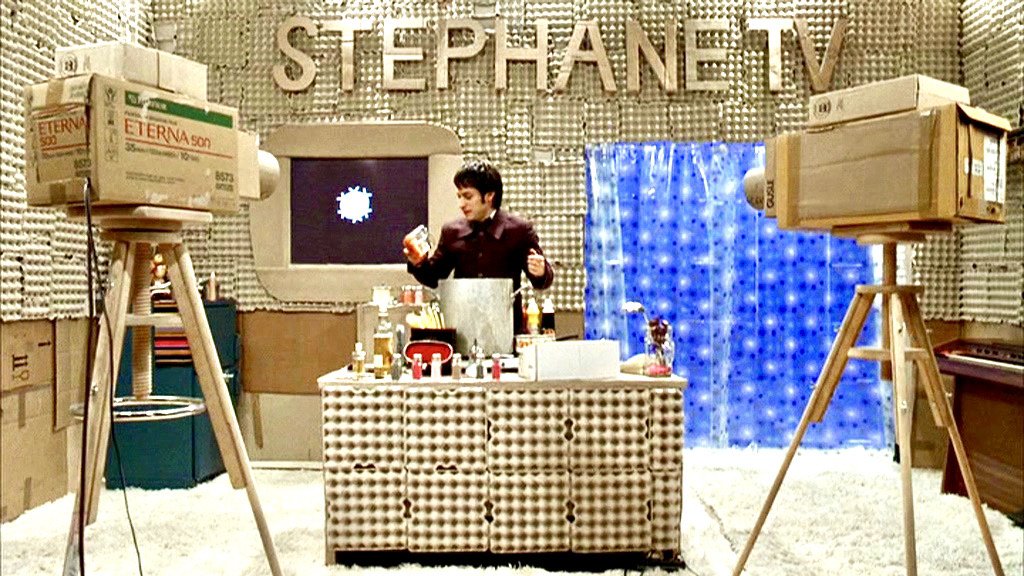I’m leaning more to creating an installation in itself, and this may or may not house a pop-up book. I describe my thinking as ‘living inside my head’, which brings to mind German expressionist film sets, such as The Cabinet of Dr Galigari, a film that shows the contrast of sanity and insanity, with painted perspectives on walls, showing dreams of a mental state, a mise en scene, a psychological representation of space.
Stephane’s cardboard TV studio in Michel Gondry’s The Science of Sleep. Image courtesy of filmgrab.com
With my previous reflections on the child’s imagination and my desire to use household detritus as art materials, I rewatch Michel Gondry’s The Science of Sleep. The awkward child-like behaviour, fun and imagination of the protagonist Stephane is shown as he navigates an adult relationship with his neighbour. When his romantic attempts go awry, he reverts to an imaginary world that is reflected in a naïve-style of moving scenery and a TV/film set made of cardboard, eggboxes and other readymades.
Reconsidering the giant pop-up book, is my project really an installation? What is it that the two projects as separate entities provide? A book covers my interest in narrativity and escapism, while a life-sized installation provides a physical environment that has the potential for viewers to be invited into another world, both physically and mentally.
Things to consider when creating a giant pop-up book as an environment include the mechanisms of turning a page – what does it mean to do this? Will pages be turned at the show as part of a performance; and who does this – me, helpers, visitors to the show? When it comes to digital vs hard copy, I’m firmly in the traditional camp because that’s what the child within the context of this project grew up with. While eBooks are great for storage and portability, they cannot compare with the tactility of a 3D book and how they allow the reader to use it – to easily go backward and forward, and not lose their place – as well as its tactility and smell. See, below, the first pop-up sketchbook I made in a display unit made from recycling an old box.
Building on the opening and closing element, I took the pop-up sketchbooks to the next level by placing them in boxes to show as part of the text exhibition last year (being a part-time student, this was the first half of my third year). Here, I based these display boxes on the kamishibai form of storytelling that was popular in Japan during the 1930s, where the narrator used picture cards in a special display box to narrate stories to a public audience.
Kamishibai has seen a resurgence in interest and is now being used as a teaching method in Japan’s primary schools. Image WriteOutLoudSD.com
For the test exhibition, I recycled old cardboard boxes, then adapted them so that there would be three different ways that readers could open them. I used Command strips to affix them to walls so they were vertical instead of the traditional horizontal mode of reading. I could have turned this into a kamishibai performance, with me being the narrator, but I wanted the other students to explore how the boxes opened and then to open the books inside.
Test exhibition of pop-up books in their display boxes. Photo Shirley A
Exploring storytelling, based on kamishibai. Photo Shirley A



